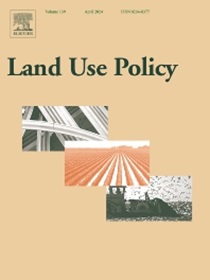在纳米比亚Omusati地区实施深度学习算法,模拟农业干旱,实现可持续土地管理
IF 6
1区 社会学
Q1 ENVIRONMENTAL STUDIES
引用次数: 0
摘要
纳米比亚的Omusati地区是一个半干旱的农业生态区,由于气候变化、降雨不稳定和土地退化,该地区面临着日益严重的农业干旱。由于70% %的人口依赖雨养自给农业,这些干旱威胁着粮食安全、生计和生态稳定,突出表明需要预测工具来支持可持续土地管理。本研究采用深度学习模型对MODIS、CHIRPS和GLDAS遥感数据进行分析,预测干旱驱动因子,包括归一化植被指数(NDVI)、蒸散量、地表温度、降雨量、土壤水分和叶面积指数。趋势分析显示,到2022年,干旱指数从2003-2015年的0.3上升到0.7以上,到2023年,树木覆盖率下降到0.08 %,裸地面积扩大,生态退化严重。预测表明,到2024年,干旱概率将增加8. %,危及81% %的农田。卷积神经网络(cnn)和长短期记忆网络(LSTMs)将NDVI和地表温度识别为关键预测因子,而卷积LSTM (ConvLSTM)提供了对高风险区域的空间洞察,尽管精度较低。这些发现可以指导在脆弱地区采用抗旱作物、节水灌溉和土壤保持的有针对性的策略。我们建议通过实时监测、社区主导的适应和机构间协调,将人工智能驱动的干旱预测纳入纳米比亚的气候和土地政策,以提高地面抵御能力。本文章由计算机程序翻译,如有差异,请以英文原文为准。
Implementation of deep learning algorithms to model agricultural drought towards sustainable land management in Namibia's Omusati region
Namibia's Omusati region, a semiarid agroecological zone, faces intensifying agricultural droughts driven by climate change, erratic rainfall, and land degradation. With 70 % of its population dependent on rain-fed subsistence farming, these droughts threaten food security, livelihoods, and ecological stability, highlighting the need for predictive tools to support sustainable land management. This study employs deep learning models to analyse remote sensing data from Moderate Resolution Imaging Spectroradiometer (MODIS), Climate Hazards Group InfraRed Precipitation with Station (CHIRPS), and Global Land Data Assimilation System (GLDAS) data to predict drought drivers, such as the normalized difference vegetation index (NDVI), evapotranspiration, land surface temperature, rainfall, soil moisture, and leaf area index. Trend analysis revealed a drought index increase from 0.3 (2003–2015) to over 0.7 by 2022, with tree cover decreasing to 0.08 % by 2023 and bare ground expanding, indicating severe ecological degradation. Projections indicate an 8 % increase in drought probability by 2024, endangering 81 % of farmland. Convolutional neural networks (CNNs), long short-term memory networks (LSTMs), identify the NDVI and land surface temperature as key predictors, whereas Convolutional LSTM (ConvLSTM) provides spatial insight into high-risk zones, although with lower accuracy. These findings can guide targeted strategies for adopting drought-resistant crops, water-efficient irrigation, and soil conservation in vulnerable areas. We recommend integrating AI-driven drought forecasts into Namibia’s climate and land policies through real-time monitoring, community-led adaptation and interagency coordination to increase on-ground resilience.
求助全文
通过发布文献求助,成功后即可免费获取论文全文。
去求助
来源期刊

Land Use Policy
ENVIRONMENTAL STUDIES-
CiteScore
13.70
自引率
8.50%
发文量
553
期刊介绍:
Land Use Policy is an international and interdisciplinary journal concerned with the social, economic, political, legal, physical and planning aspects of urban and rural land use.
Land Use Policy examines issues in geography, agriculture, forestry, irrigation, environmental conservation, housing, urban development and transport in both developed and developing countries through major refereed articles and shorter viewpoint pieces.
 求助内容:
求助内容: 应助结果提醒方式:
应助结果提醒方式:


